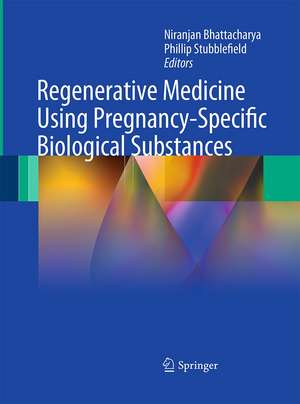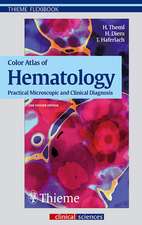Regenerative Medicine Using Pregnancy-Specific Biological Substances
Editat de Niranjan Bhattacharya, Phillip Stubblefielden Limba Engleză Paperback – 25 sep 2014
Attention is yet to be focused on the widespread clinical use of pregnancy-related biological substances. The aim for this book is to inform clinicians of the use of such materials and increase awareness of their therapeutic benefits. As such, this reference resource will be of great value to hematologists, rheumatologists, cardiologists, transplant technologists and all involved in regenerative medicine.
| Toate formatele și edițiile | Preț | Express |
|---|---|---|
| Paperback (1) | 1425.51 lei 38-44 zile | |
| SPRINGER LONDON – 25 sep 2014 | 1425.51 lei 38-44 zile | |
| Hardback (1) | 1320.75 lei 38-44 zile | |
| SPRINGER LONDON – 29 dec 2010 | 1320.75 lei 38-44 zile |
Preț: 1425.51 lei
Preț vechi: 1500.53 lei
-5% Nou
Puncte Express: 2138
Preț estimativ în valută:
272.76€ • 284.79$ • 225.75£
272.76€ • 284.79$ • 225.75£
Carte tipărită la comandă
Livrare economică 01-07 aprilie
Preluare comenzi: 021 569.72.76
Specificații
ISBN-13: 9781447157335
ISBN-10: 1447157338
Pagini: 496
Ilustrații: XXXV, 460 p.
Dimensiuni: 193 x 260 x 26 mm
Greutate: 0 kg
Ediția:2011
Editura: SPRINGER LONDON
Colecția Springer
Locul publicării:London, United Kingdom
ISBN-10: 1447157338
Pagini: 496
Ilustrații: XXXV, 460 p.
Dimensiuni: 193 x 260 x 26 mm
Greutate: 0 kg
Ediția:2011
Editura: SPRINGER LONDON
Colecția Springer
Locul publicării:London, United Kingdom
Public țintă
Professional/practitionerDescriere
The proposed book is a holistic review of the clinical use of placental substances, amniotic fluid, the umbilical cord and its contents. It is intended to be a unique presentation of the current advances as well as also discussing the future applications of these substances.
Attention is yet to be focused on the widespread clinical use of pregnancy-related biological substances . The aim for this book is to inform clinicians of the use of such materials and increase awareness of their therapeutic benefits. As such, this reference resource will be of great value to hematologists, rheumatologists, cardiologists, transplant technologists and all involved in regenerative medicine.
Attention is yet to be focused on the widespread clinical use of pregnancy-related biological substances . The aim for this book is to inform clinicians of the use of such materials and increase awareness of their therapeutic benefits. As such, this reference resource will be of great value to hematologists, rheumatologists, cardiologists, transplant technologists and all involved in regenerative medicine.
Cuprins
Foreword
Section 1
Massive wastage of Pregnancy Specific biological substances
Section 1
Massive wastage of Pregnancy Specific biological substances
- Massive Wastage of the Global Resources
Section 2:
Basic science and Placental use - Placenta as a source of stem cells and as a key organ for fetomaternal tolerance
- Use of Placenta as Medicine: Placenta and Umbilical Cord in Traditional Chinese
Medicine
Section 3:
Cardiovascular and angiology - Umbilical vein graft for lower limb revascularisation
- Use of umbilical venous blood on assessing the biochemical variations of acid-base, nutritional and metabolic parameters on growth-retarded fetuses, in comparison with gestational control cases: A study.
- Cord Blood Stem Cells in Angiogenesis
- Endothelial Progenitor Cells From Cord Blood: Magic Bullets Against Ischemia?
Section 4:
Cord blood Transfusion perspectives - Use of Placental Umbilical cord blood in transfusion Medicine
- Use of Placental Umbilical cord blood in Paediatrics
- Clinical Experience of Cord blood autologous transfusion
- Emergency Use of Human Cord Blood
- hemoglobin based oxygen carriers in trauma CARE: The U. S. Multicenter Prehosptial trial.
- Cord blood as transfusion substitute in Emergency.
Section 5:
Use of Placental Umbilical cord blood in subspecialities of Regeneration medicine in neurology - Anti-inflammatory effects of human cord blood and its potential implication in neurological disorders
- Transforming "waste" into gold: Identification of Novel stem cell resources with therapeutic potential in neuromuscular disorders
- Human Umbilical Cord Blood Cells for Stroke
- Cord blood in Neurology
Section 6:
Immunotherapy potential of Fetal Cell in Maternal System - Implications of feto-maternal cell transfer in normal pregnancy
- Immunotherapy potential of Cord blood transfusion in cases of advanced breast Cancer
Section 7:
Use of Placental Umbilical cord blood in Orthopaedics - Cord Blood – An alternative source for bone regeneration
Section 8:
Use of Placental Umbilical cord blood serum in Opthalmology - Umbilical Cord Blood Use in Opthalmology
Section 9:
Use of Placental Umbilical cord blood in Cardiology - Therapeutic Potential of Placental Umbilical Cord Blood in Cardiology
- Cord Blood in Cardiology
- Cord blood in Myocardial infarction
Section 10:
Use of Placental Umbilical cord blood in other subspecialities of Regeneration Medicine - Umbilical cord-derived mesenchymal stem cells
- Cord Blood Stem Cell Expansion ex vivo: Current Status and Future Strategies
- Advances in cord blood regeneration
- Use of Non-hematopoietic stem cells of fetal origin from cord blood, umbilical cord and placenta in Regeneration Medicine
- Animal Studies of Cord Blood and Regeneration
- Immune privileges of Cord Blood
- Cord Blood in Regenerative Medicine: Recent advances
Section 11:
Clinical use of Amniotic fluid - Placenta and amniotic fluid: a massive wastage of human resources - a perspective on its current and potential use
- Use of Amniotic fluid in non healing ulcer dressing
Section 12:
Cord blood collection variability and Banking - Comparisons between Related and Unrelated Cord Blood Collection and/or Banking for Transplantation or Research
- Donor and Collection-related Variables Affecting Product Quality in Ex-utero Cord Blood Banking
- Collection of cord blood as a source of hematopoietic progenitors for transplantation
Section 13:
Ethics - Ethical issues surrounding Umbilical Cord Blood donation and banking
Recenzii
From the reviews:
“This book describes clinical and preclinical research involving the use of the human umbilical cord, amnion, and placenta for regenerative medicine. It contains a wealth of information and new ideas. … It is written for clinicians and basic science researchers interested in pregnancy and regenerative medicine … . documents innovative approaches to regenerative medicine using cord blood and other pregnancy-associated substances. Carefully edited, it provides a fascinating snapshot of current research. This is an important topic that is not often addressed.” (Bruce A. Fenderson, Doody’s Review Service, January, 2012)
“This book describes clinical and preclinical research involving the use of the human umbilical cord, amnion, and placenta for regenerative medicine. It contains a wealth of information and new ideas. … It is written for clinicians and basic science researchers interested in pregnancy and regenerative medicine … . documents innovative approaches to regenerative medicine using cord blood and other pregnancy-associated substances. Carefully edited, it provides a fascinating snapshot of current research. This is an important topic that is not often addressed.” (Bruce A. Fenderson, Doody’s Review Service, January, 2012)
Textul de pe ultima copertă
Regenerative Medicine Using Pregnancy Specific Biological Substances is an international attempt to bring researchers working on the potential uses of pregnancy specific biological substances in regenerative medicine, under one umbrella. More than 72 distinguished authors from five continents have contributed in the 40 chapters of the book. It will be a good reference source, not only for practicing clinicians, but also for those interested in research in immunotherapy; stem cell therapy; regenerative therapy and various specialities such as cardiology, neurosurgery and cardiothoracic surgery. This book brings together some of the important work that is being done along with unpublished observations that will help to shape the contours of future therapy in the field of modern regenerative medicine. It promises to be an eye-opener to the enormous potential of hitherto discarded material that had been so far considered as a pure biological waste. The book will have served its purpose if it acts as a stimulant to professionals and clinical scientists who can build on the knowledge and expand the curative potential of pregnancy-specific biological substances
Caracteristici
Analyses pregnancy specific substance use and potential in regenerative medicine and surgery
Explores potential for cord blood in cardiovascular surgery applications
Reviews use of amniotic fluid as cell therapy in arthritis with degeneration
Includes supplementary material: sn.pub/extras
Explores potential for cord blood in cardiovascular surgery applications
Reviews use of amniotic fluid as cell therapy in arthritis with degeneration
Includes supplementary material: sn.pub/extras








